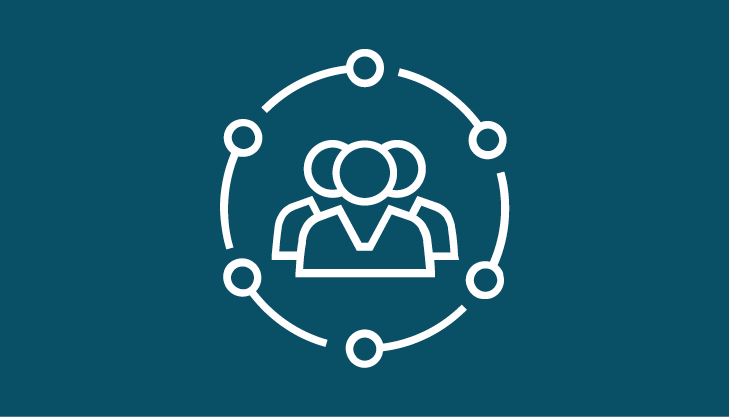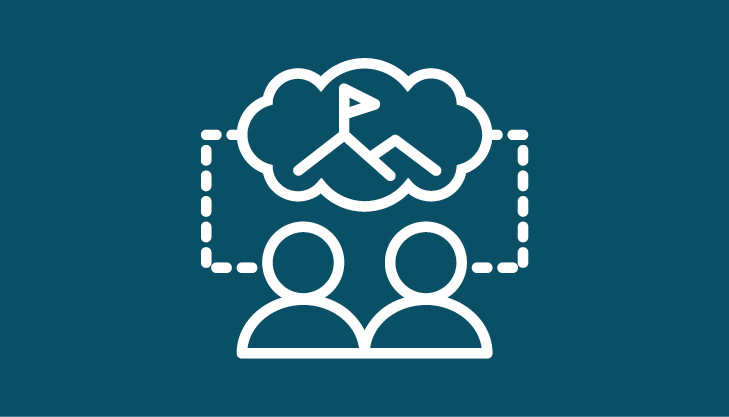Increasing Context Around Our Outcomes
The Impact of COVID-19
In 2020, the COVID-19 pandemic reshaped how our community learns, and disrupted many aspects of our day-to-day lives. It also illuminated existing inequalities that are now increasing due to a range of public health and economic impacts.
What is the Impact of COVID-19 Review?
This page includes a synthesis of local data and peer-reviewed literature to help us better understand the context of these conditions around the COVID-19 pandemic and the potential effects it may have on our educational outcomes. This content looks specifically at how the pandemic is impacting student learning and wellbeing both locally and across the U.S.
This material does not serve as an exhaustive review of literature, but rather a sample to illuminate concepts, raise awareness, and increase understanding of the connections between systemic conditions and educational outcomes. Content gathered from peer-reviewed literature is typically not specific to Forsyth County; information that is specific to our community has been noted as such.
The literature review contained on this page was produced by Forsyth Futures, a registered 501(c)(3) organization that provides action-oriented data analysis and reporting services to organizations within Forsyth County. Forsyth Futures studies our community to inform action. If you have questions about Forsyth Futures or about the data contained in this report, please contact info@forsythfutures.org.
The Forsyth Promise 2020 Education Report
The purpose of this report is share community information so that everyone can better understand our educational systems. This report is produced annually by The Forsyth Promise.
We Value Your Feedback
Please use this Google form to provide feedback.
The Impact of COVID-19 on Student Learning and Wellbeing
Some experts suggest that student learning during the COVID-19 pandemic could have lasting implications for individuals, communities, and the economy.
The COVID-19 pandemic has shifted everyday life and presented new hardships for many families and households [1]. The pandemic has also illuminated the existing inequality present in various facets of society that is now being exacerbated by the public health and economic impact of COVID-19 [1]. For the purposes of this discussion we will focus on the impact of COVID-19 on student learning and wellbeing and potential strategies to better support our community in coping with the effects of the pandemic.
The Impact of COVID-19
Through a Local Data Lens
The COVID-19 pandemic pushed virtually all instruction online in the spring and fall of 2020. Due to internet access challenges and other barriers, online instruction has the potential to exacerbate existing inequities (see below for the WS/FCS and community responses to internet access challenges and other barriers). The percent of students who had zero online instructional activity on a week-by-week basis in the fall of 2020 is provided below as a measure engagement in instruction. View data notes for this measure.
Data Visualization
Zero Online Engagement in the Fall
Use the dropdown menu below to view data on different groups. When viewing disaggregation by school, click the name of a school below the graph to view that school on its own.
Key Takeaways
Disparities were present in online engagement by race/ethnicity.
Black and Hispanic/Latino students had lower rates of engagement in online instruction compared to White students.
Data Notes
Zero Online Engagement in the Fall
No online engagement for lower grades — Kindergarten, first, and second — is likely higher due to less instruction being provided in online formats.
Data source: Winston-Salem/Forsyth County Schools
The Impact of COVID-19
Through a Scan of Published Literature
About this Literature Scan | Glossary terms used in this section: digital divide.
Due to school closures to prevent the spread of the COVID-19 virus, students, families, teachers, and communities were required to act quickly to identify a method to ensure students were able to safely learn at home or in remote learning centers. Remote/virtual learning presented a number of unique challenges and highlighted the gap in access to internet connectivity and adequate devices, especially among households with limited income and economic resources [2]. While school systems throughout the country found ways to increase access to internet connectivity and devices, student engagement and learning continues to require strategic planning to better support teachers and help students navigate this form of instruction [2,3].
Some experts suggest that student learning during the COVID-19 pandemic could have lasting implications for individuals, communities, and the economy [4]. There’s a potential for increased learning loss, and an increase in the dropout rate which could impact future employment opportunities and earning potential for students well into adulthood [4]. Researchers predict the graduation rate and learning loss will return to pre-COVID estimates fairly quickly, however it’s important to consider strategies to support students and those who decide to drop out [5].
In addition to disruptions in learning and shifting from traditional school instruction, teachers, students and families are trying to navigate emotional and mental stressors related to the pandemic [6]. The pandemic has presented communities with unique challenges that many leaders and community members have not encountered before. Coupled with existing stressors, multiple hardships like loss of a loved one, childcare burden, and unemployment can impact mental and emotional wellbeing of families, students, and teachers [6].
While the COVID-19 pandemic continues to evolve, communities and school systems will need to prepare to increase access to mental health services and support within the community and schools [6].Teachers may also benefit from additional training and resources to support virtual engagement and ways to assist students who may be at risk for falling behind their grade level [5]. Strategies and supportive services to assist our community in navigating these challenges will require creative thinking, collaboration, and funding.
Access to Technology in the Time of COVID-19
Bridging the digital divide has been widely discussed due to the increasing need for internet connectivity for households and students as they move through the K-12 educational system, even prior to the COVID-19 pandemic. Initial investments in internet connectivity focused on in-school, after-school programming, and on-site computer labs to reduce the “homework gap” [7]. While efforts to increase access to internet connectivity and devices have been promising, they mostly focus on public spaces and can still leave some households without equal access when compared to their peers who have these resources in their homes [7,8].
Due to the COVID-19 pandemic and the increase in remote or virtual learning approaches, many communities quickly saw that limited internet access and devices negatively impacts school-aged childrens’ and instructors’ ability to engage and participate in valuable instruction time [2,7]. An estimated 50 million U.S. public school children shifted to online learning; of the 50 million, an estimated 9 million public school students lacked access to stable and adequate equipment and internet access [2]. In addition to students, according to national estimates, the digital divide also negatively impacts U.S. instructors and teachers, with an estimated 300-400 thousand lacking internet access, and an estimated 100,000 lacking reliable devices [2].
While remote learning may not be an ongoing method of instruction for K-12 students, the increasing need for internet access is a critical issue that many communities will need to address. According to the experts, while the remote learning approach for K-12 may be temporary, there are opportunities for communities, educators, and policy makers to better support students and prepare them for careers and a future that may require more remote approaches to life [8].
To close the digital divide for K-12 students, experts estimate it would cost the United States $11 billion in the first year as well as long-term sustainable strategies [2].
Key Events in the WS/FCS Response to COVID-19
- Mid-March, 2020
- WS/FCS quickly began planning and implementing strategies to support remote learning during the duration of school closures intended to reduce the spread of the COVID-19 virus [9].
- WS/FCS and local schools coordinated the distribution of Chromebook devices, mobile hotspots, and take-home packets to support remote learning efforts [9].
- In addition to supporting device and mobile hotspot internet access, the school system, in collaboration with local community centers, is working to distribute and free- and reduced-price meals at sites throughout the county, as well as through direct delivery [10].
- WS/FCS is currently working towards moving forward with a phased approach to a safe return to school plan that would ensure the safety of both students, teachers, and staff [11].
Key Takeaways
Our education system and entire community has experienced a shift and disruptions in everyday life.
(Gassman-Pines, Ananat, & Fitz-Henley 2020)
Existing inequality has been illuminated and increased by the challenges presented by the COVID-19 Pandemic.
(Gassman-Pines, Ananat, & Fitz-Henley 2020)
While the remote learning approach for K-12 may be temporary, there are opportunities for communities, educators, and policy makers to better support students and prepare them for careers and a future that may require more remote approaches to life.
(Vegas & Winthrop, 2020)

Stories of Lived Experience
“I think we have a lot of work to do all the way around when it comes to internet and like our rural areas getting internet. […] And I feel like COVID has really given everyone a new perspective on what it is that teachers actually go through…”
NATASHIA ALEXANDER, Parent of a Kindergartener in WS/FCS; Child Care Resource Center
Go to the lived experience interviews

Stories of Lived Experience
“Many of our parents did not have internet before the pandemic hit. Fortunately, some of our families have relied on our Boys & Girls Club as a remote learning site.”
MRS. SYLVIA ADAMS, Executive Director, The Salvation Army Ken Carlson Boys & Girls Club
Go to the lived experience interviews

Stories of Lived Experience
“COVID’s impact on our students and education system has yet to be seen.”
TONYA L. WOODS, Parent of a 5th Grade WS/FCS Student
Go to the lived experience interviews
The Impact of COVID-19
Literature Scan Citations
| 1 | Gassman-Pines, A., Ananat, E. O., & Fitz-Henley, J. (2020). COVID-19 and parent-child psychological well-being. Pediatrics, 146(4). |
| 2 | Chandra, S., Chang, A., Day, L., Fazlullah, A., Liu, J., McBride, L., Mudalige, T., Weiss, D., (2020). Closing the K–12 Digital Divide in the Age of Distance Learning. https://www.commonsensemedia.org/sites/default/files/uploads/pdfs/common_sense_media_report_final_7_1_3pm_web.pdf |
| 3 | Borup, J., Jensen, M., Archambault, L., Short, C.R. & Graham, C.R. (2020). Supporting Students During COVID-19: Developing and Leveraging Academic Communities of Engagement in a Time of Crisis. Journal of Technology and Teacher Education, 28(2), 161-169. Waynesville, NC USA: Society for Information Technology & Teacher Education. Retrieved December 15, 2020 from https://www.learntechlib.org/primary/p/216288/. |
| 4 | Dorn, E., Hancock, B., Sarakatsannis, J., & Viruleg, E. (2020a). COVID-19 and learning loss- disparities grow and students need help. McKinsey & Company. https://www.mckinsey.com/industries/public-and-social-sector/our-insights/covid-19-and-learning-loss-disparities-grow-and-students-need-help |
| 5 | Dorn, E., Hancock, B., Sarakatsannis, J., & Viruleg, E. (2020b). COVID-19 and student learning in the united states: The hurt could last a lifetime. McKinsey & Company. https://www.mckinsey.com/industries/public-and-social-sector/our-insights/covid-19-and-student-learning-in-the-united-states-the-hurt-could-last-a-lifetime# |
| 6 | Weisbrot, D. M., & Ryst, E. (2020). Debate: Student mental health matters - the heightened need for school-based mental health in the era of COVID-19. Child and adolescent mental health, 25(4), 258–259. https://doi.org/10.1111/camh.12427 |
| 7 | Lee, N. (2020) Bridging the digital divides between schools and communities. Brookings Institute. https://www.brookings.edu/research/bridging-digital-divides-between-schools-and-communities/ |
| 8 | Vegas, E., & Winthrop, R. (2020) Beyond reopening schools: How education can emerge stronger than before covid-19. Brookings Institute. https://www.brookings.edu/research/beyond-reopening-schools-how-education-can-emerge-stronger-than-before-covid-19/ |
| 9 | O’Donnell, L. (2020, March 18). Online learning begins thursday in winston-salem/forsyth county schools. Winston-Salem Journal. Retrieved from https://journalnow.com/news/local/online-learning-begins-thursday-in-winston-salem-forsyth-county-schools/article_fdce6840-25cb-5b2c-9f1d-9c45238b7bba.html |
| 10 | Child nutrition services: School meals pickup and delivery. (2020). Winston-Salem/ Forsyth County School System. |
| 11 | Our Safe Return: Phased school reopening plan underway. (2021). Winston-Salem/ Forsyth County School System. https://www.wsfcs.k12.nc.us/Page/115981 |
Pathways to Action
We can work together to organize, advocate, and drive positive change.
When we work together, we have the power to change our systems for the better. We hope those who read this report feel encouraged and inspired to get involved. Local groups are working to support and improve our systems and there are many ways for anyone to get involved.
Get Engaged in the Community Conversation on Education
Join us for Be The Change: Making Good on Our Promise, a digital convening designed to bring people together and discuss coordinated community-wide action to increase equity and improve outcomes.
Learn About Work Being Done to Improve Our Educational Systems
Initiative Action Profiles highlight current, collaborative, community work to improve our systems of education.
Help Improve this Report by Sharing Your Feedback
Each year, The Forsyth Promise publishes a community report on Forsyth County's educational systems. By taking just a moment to share your thoughts on the 2020 report, you can help make future reports better.
Help Us Build a More Complete Perspective
Help us understand important aspects of our educational systems that this report may have overlooked or suggest new information to improve the report.
Find a Volunteer Opportunity that's Right for You
Everyone in our community possesses important gifts, skills, and talents they can use to help make Forsyth County a better place to live.
Share the Story of Your Lived Experience
Forsyth County residents of all ages, lifestyles, and backgrounds can participate in our Lived Experience Lab, through which we capture and share critical community stories about educational experiences.
Data Notes
Online Engagement in the Fall
Lorem ipsum dolor sit amet, consectetur adipiscing elit. Integer pellentesque nisl eros, vitae volutpat felis sollicitudin ac. Aliquam suscipit porttitor laoreet. Nunc tortor dui, varius non massa venenatis, dapibus viverra nunc. Etiam facilisis eleifend arcu, vel sagittis mi egestas quis. Donec imperdiet tristique lectus, eget molestie lorem convallis ac. Phasellus pellentesque ut mauris id dapibus. Duis pulvinar ex sed velit placerat, sit amet egestas erat porta.
Morbi mi nisl, semper at mi nec, finibus faucibus augue. Praesent laoreet, ante quis vehicula suscipit, nisl ante aliquet leo, vitae luctus augue ante eget lacus. Morbi ullamcorper facilisis felis vel mollis. Nam vitae diam urna. Donec viverra sollicitudin enim non commodo. Vestibulum ante ipsum primis in faucibus orci luctus et ultrices posuere cubilia curae; Nulla maximus odio nunc, sed ornare odio dapibus ultricies. Curabitur auctor eu magna eget semper. Etiam maximus nunc rutrum, consequat leo quis, accumsan ex.







